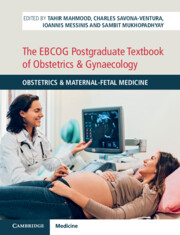Book contents
- The EBCOG Postgraduate Textbook of Obstetrics & Gynaecology
- The EBCOG Postgraduate Textbook of Obstetrics & Gynaecology
- Copyright page
- Dedication
- Contents
- Contributors
- Preface
- Section 1 Basic Sciences in Obstetrics
- Chapter 1 Surgical Anatomy of the Female Pelvis
- Chapter 2 Maternal Physiology during Pregnancy, Including Immunology of Pregnancy
- Chapter 3 Developmental Abnormalities of the Reproductive System and Their Relevance to Obstetric Practice
- Chapter 4 Pharmacology and Pharmacokinetics in Obstetric Practice
- Chapter 5 Genetics in Fetomaternal Medicine
- Section 2 Early Pregnancy Problems
- Section 3 Fetal Medicine
- Section 4 Maternal Medicine
- Section 5 Intrapartum Care
- Section 6 Neonatal Problems
- Section 7 Placenta
- Section 8 Public Health Issues in Obstetrics
- Section 9 Co-Morbidities during Pregnancy
- Index
- Plate Section (PDF Only)
- References
Chapter 2 - Maternal Physiology during Pregnancy, Including Immunology of Pregnancy
from Section 1 - Basic Sciences in Obstetrics
Published online by Cambridge University Press: 20 November 2021
- The EBCOG Postgraduate Textbook of Obstetrics & Gynaecology
- The EBCOG Postgraduate Textbook of Obstetrics & Gynaecology
- Copyright page
- Dedication
- Contents
- Contributors
- Preface
- Section 1 Basic Sciences in Obstetrics
- Chapter 1 Surgical Anatomy of the Female Pelvis
- Chapter 2 Maternal Physiology during Pregnancy, Including Immunology of Pregnancy
- Chapter 3 Developmental Abnormalities of the Reproductive System and Their Relevance to Obstetric Practice
- Chapter 4 Pharmacology and Pharmacokinetics in Obstetric Practice
- Chapter 5 Genetics in Fetomaternal Medicine
- Section 2 Early Pregnancy Problems
- Section 3 Fetal Medicine
- Section 4 Maternal Medicine
- Section 5 Intrapartum Care
- Section 6 Neonatal Problems
- Section 7 Placenta
- Section 8 Public Health Issues in Obstetrics
- Section 9 Co-Morbidities during Pregnancy
- Index
- Plate Section (PDF Only)
- References
Summary
Pregnancy is a specific relationship between two or more organisms inside their unique ecosystem. Although they belong to the same species, the relationship can be qualified as a symbiotic and parasitic form of biological interaction [1]. The question might be rooted more in the psychology rather than physiology of pregnancy. On the other hand, however, a fetus does control maternal adaptation to pregnancy, and for its successful development and growth it needs an effective exchange of nutritive and metabolic products with the mother, combined with a reliable life-support system composed of the placenta, umbilical cord and amniotic sac.
- Type
- Chapter
- Information
- The EBCOG Postgraduate Textbook of Obstetrics & GynaecologyObstetrics & Maternal-Fetal Medicine, pp. 8 - 18Publisher: Cambridge University PressPrint publication year: 2021

